One of the most beautiful and most romantic plants is the Dutch bulbous iris. Planting and caring for it is a bit of a hassle, but it will more than pay off for you with a beautiful flowering flower bed. Outwardly, it is somewhat reminiscent of a tropical butterfly, sitting on a stalk in order to rest and continue to fly around the world. Thanks to its beauty, iris instantly captivated gardeners. Almost no flower bed can do without it.
Description and varieties
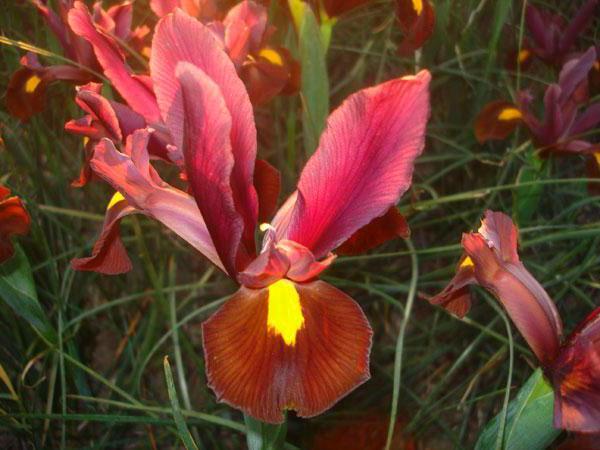 We take the Dutch iris (Iris Hollandica) as a basis.
We take the Dutch iris (Iris Hollandica) as a basis.
To begin with, let's move away from the topic and mention that heat-loving irises have three main varieties:
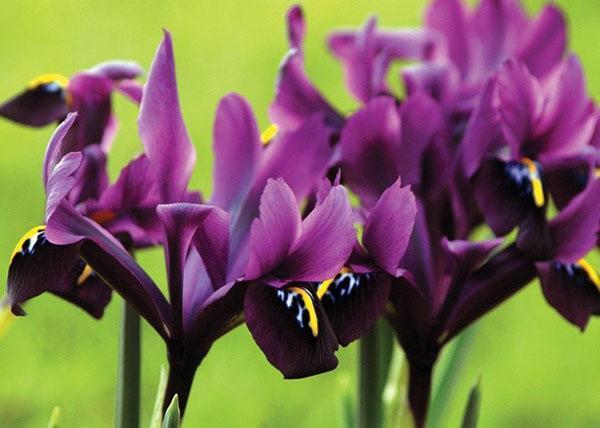
Dutch iris is a xifium, and belongs to the hybrid varieties of the Dutch category, bred in the country of the same name. In flower shops, they are sold in the form of bulbs covered with multiple layers of scales. In adult form, the height of the plant is on average 0.6 m, but it all depends on the variety. For example, in iris Dutch Blue Diamond (blue diamond), Casablanca, Blue Magic (blue magic) and others, the height varies between 0.45-0.7 m.
If you plant irises in places inaccessible to the wind, they will not need supports.
The plant itself is winter hardy. However, in severe frosts, they need to be covered with something in order to prevent freezing. have found wide application. They not only decorate flower beds of gardens and flower beds, but also grow under the cut to create bouquets and flower arrangements.
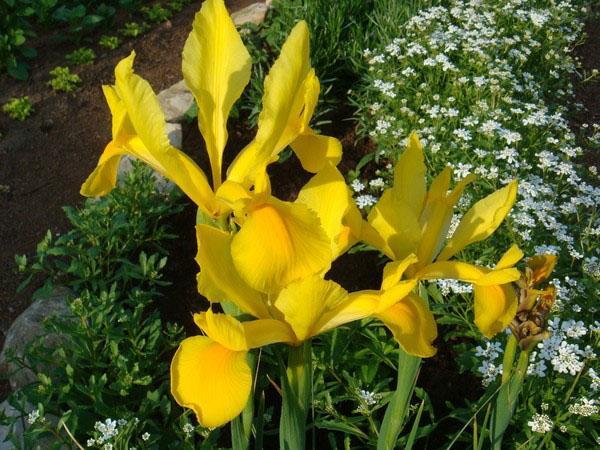 The flowering of the Dutch iris (photos are presented below) occurs in the last week of May and continues until the beginning of June. As for the spectrum of shades of buds, they can be very diverse, from white and blue to orange and purple. After flowering, the plant begins to dry the foliage, and by the end of August it dries completely.
The flowering of the Dutch iris (photos are presented below) occurs in the last week of May and continues until the beginning of June. As for the spectrum of shades of buds, they can be very diverse, from white and blue to orange and purple. After flowering, the plant begins to dry the foliage, and by the end of August it dries completely.
Dutch bulbous iris: planting
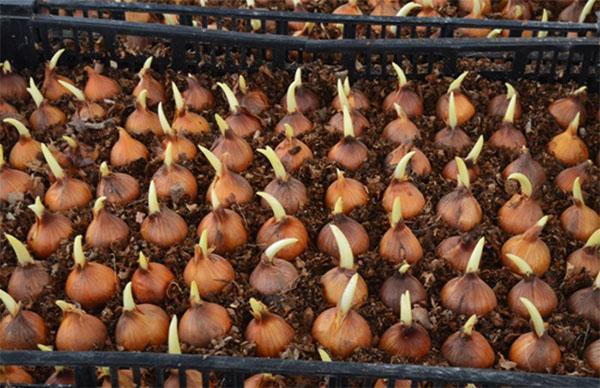 In principle, the planting of bulbous irises is identical to the root ones. But still there are a number of nuances that must be strictly followed:
In principle, the planting of bulbous irises is identical to the root ones. But still there are a number of nuances that must be strictly followed:
- The growing season of bulbous irises is quite short. Flowering comes late, towards summer, and quickly stops. Therefore, it is important to choose the right material for planting. In this case, you should pay attention to the golden color of the bulbs, the absence of dark spots or soft zones. The development of the plant and the condition depend on the correct choice.
- Before planting, the flower bulbs must be dipped in a fungicide solution and kept there for several hours. This procedure protects it from rotting in the ground. After the aged onion is thoroughly dried.
- Bulbous Dutch iris is planted in the spring.
- The land in the flower bed or in the place where the irises will be planted should be plowed in advance, and then disinfected with potassium permanganate (just water it.). This will help get rid of germs, bacteria that can harm the bulb and destroy the plant.
- Bulbs are planted when roots begin to appear. At the same time, they are planted to a depth of 10-15 cm, keeping a distance of 15 cm between specimens. This distance will ensure good development and growth of the plant and will not allow shading each other in a group with each other.
- Planted bulbs are sprinkled with soil and watered well.
Basic rules for caring for bulbous Dutch iris
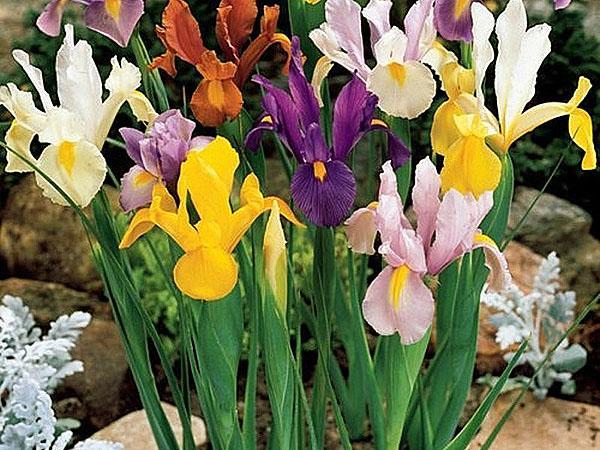 In order for the plant to develop without complications and please flowering for a long time, a number of rules for caring for flowers should be followed.
In order for the plant to develop without complications and please flowering for a long time, a number of rules for caring for flowers should be followed.
Lighting
Irises are photophilous plants, so for planting it is necessary to choose dry and well-lit places. But at the same time, they need to be protected from direct sunlight. An ideal place for a flower bed is partial shade with sufficient illumination.
The soil
As for the substrate, nutritious and loose soil is important for irises. At the same time, its pH should be alkaline or neutral. If the indicators differ or a clay substrate prevails on the site, then adding sand to prevent water stagnation, as well as adding slaked lime to adjust the pH to the desired value, will help correct the situation.
Irises prefer loose soil, so loosening should be done regularly after planting. 1-2 times/week will be enough.
Watering
Since irises are very sensitive to waterlogging of the soil (this leads to rotting of the roots and further death of the entire bulb), good drainage must be taken care of before planting so that water can “leave” and not accumulate at the planting site.
Russia is characterized by rainy seasons, so after flowering the bulbs are recommended to be dug up, dried and put in a dry place for storage.
top dressing
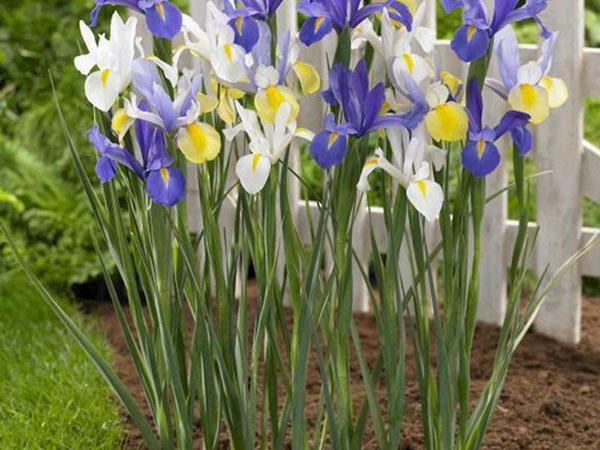 Also, the plant does not tolerate the effects of any chemicals. Therefore, you need to be very careful with top dressing. It is better to opt for compost or humus, in the amount of 1 bucket / m 2. After planting the bulbs, the plants can be "fed" with wood ash.
Also, the plant does not tolerate the effects of any chemicals. Therefore, you need to be very careful with top dressing. It is better to opt for compost or humus, in the amount of 1 bucket / m 2. After planting the bulbs, the plants can be "fed" with wood ash.
Often in stores they sell Dutch mix iris. Planting and caring for such bulbs is identical. Only the color of the buds will be a "surprise" for you.
Now you know how and when to plant Dutch irises. Compliance with all the rules will allow you to grow plants of amazing beauty and revive your site with bright colors.
Video about bulbous irises













